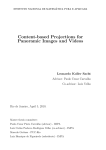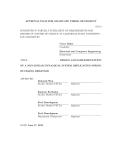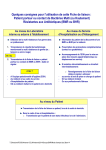Download User's guide for R package simMSM
Transcript
User’s guide for R package simMSM
Holger Reulen,
Chair of Statistics,
University of Goettingen
June 5, 2013
The Package simMSM provides R functions to simulate event histories. The
underlying multi state model is parameterized by possibly nonlinear baseline
hazard rate functions as well as possibly nonlinear covariate effect functions.
Sampling of event histories is then performed using inversion sampling on
all-cause hazard rate functions.
This guide gives some background theory in section 1, prints the implemented source code in section 2 and shows the results of 10 simulation replications of an event history dataset in section 3. The simulation is based on
a 4 state multi state model with 6 possible transitions and 2 covariates. The
results are verified using software BayesX and R package etm in subsections
3.3 and 3.4.
Contents
1 The theory behind simMSM in a nutshell
2
2 Implementation of simMSM...
3
3 ... and how we can use it.
3.1 Parameterization . . . . . . . .
3.2 Simulation . . . . . . . . . . . .
3.3 Check the results using BayesX
3.3.1 Baseline hazard rates .
3.3.2 Covariate effects . . . .
3.4 Check the results using etm . .
.
.
.
.
.
.
.
.
.
.
.
.
1
.
.
.
.
.
.
.
.
.
.
.
.
.
.
.
.
.
.
.
.
.
.
.
.
.
.
.
.
.
.
.
.
.
.
.
.
.
.
.
.
.
.
.
.
.
.
.
.
.
.
.
.
.
.
.
.
.
.
.
.
.
.
.
.
.
.
.
.
.
.
.
.
.
.
.
.
.
.
.
.
.
.
.
.
.
.
.
.
.
.
.
.
.
.
.
.
.
.
.
.
.
.
.
.
.
.
.
.
.
.
.
.
.
.
.
.
.
.
.
.
.
.
.
.
.
.
.
.
.
.
.
.
7
7
9
10
11
12
13
1 The theory behind simMSM in a nutshell
simMSM simulates event histories using inversion sampling which was outlined before for
general multi state models in section 7 of Kneib and Hennerfeind (2008)1 and described
more explicitly for a single competing risks scenario in section 3.2 of Beyersmann et al.
(2012)2 .
In brief inversion sampling is performed in the following way:
1. The multi state model and its stochastic behaviour is fully determined by the
transition specific hazard rate functions λkl (t). So for a specific initialP
state k, the
integral from 0 to t over the all-cause hazard rate function λk (t) = l6=k λkl (t),
the cumulative all-cause hazard rate function Λk (t), specifies the distribution of
sojourn times Tk in state k. We therefore perform simulation of sojourn times Tk
based on the cumulative all-cause hazard rate functions.
2. For given Tk we can draw the final state j for our current transition using a one-trial
multinomial distribution with probabilities pkj calculated as
λkj (t)
, j = 1, . . . , q and j 6= k.
l6=k λkl (t)
pkj = P
Step 1 includes the inversion sampling step which maybe needs more explanantion. As
the hazard rate function λkl (t) are positive functions, the integral from 0 to t over the
sums of these functions are strictly increasing and invertible. As already stated above,
the cumulative all-cause hazard rate function Λk (t) specifies the probability distribution
function of sojourn times Tk by
Fk (t) := P (Tk ≤ t) = 1 − exp (−Λk (t))
Consequently the probability distribution function Fk is invertible as well.
Since I don’t want to reinvent the wheel here and I could impossibly write it down any
better, next up a (slightly adapted) quotation from Beyersmann et al. (2012), p. 47,
that describes the remainder of the inversion sampling procedure:
−1
”We write F−1
k for the inverse of Fk and Λk (t) for the inverse of Λk (t).
Consider the transformed sojourn time Fk (Tk ). The key of the inversion
method is that Fk (Tk ) is uniformly distributed on [0, 1]:
P (F (T ) ≤ u) = P T ≤ F−1 (u) = F F−1 (u) = u, u ∈ [0, 1] .
Hence, if U is a random variable with uniform distribution on [0, 1], then
Fk (U ) has the same distribution as T . The inversion method works as follows:
1
Kneib, T., Hennerfeind, A. (2008): Bayesian semi parametric multi-state models, Statistical Modelling,
vol. 8, no. 2, p. 169-198.
2
Beyersmann, J., Allignol, A., Schumacher, M. (2012): Competing Risks and Multistate Models with
R, Series: Use R!, Springer, Berlin.
2
−1
1. Compute F−1
k (u) = Λk (− log (1 − U )), U ∈ [0, 1].
2. Choose a realization u that is uniformly distributed on [0, 1].
3. F−1
k (u) is the desired replicate of Tk .
Sometimes, the λkl (t) are chosen in such a manner that we do not find an
explicit expression for Λ−1
k . We may then use numerical inversion.”
We will use a Cox-type parameterization of the transition-specific hazard rate functions
in the following:
(0)
λkl (ti ) := λkl (ti ) · exp ηikl ,
(0)
with transition-specific baseline hazard rates λkl (ti ) and transition- as well as individualkl
kl
specific linear predictors ηikl = fkl
x1 (x1i ) + fx2 (x2i ) + . . . + fxp (xpi ).
kl
kl
fkl
x may be a linear function fx (xi ) = βx · xi as well as any other function, e.g. piecewise
constant, piecewise linear, trigonometrical, polynomial or any mixture of these function
classes.
The same applies for baseline hazard rate functions, with the additional requirement
that they have to be positive.
2 Implementation of simMSM...
>
>
>
>
>
>
>
#setwd("P:/home/research/06_project_sim_package")
#install.packages("simMSM_1.0.tar.gz", type="source")
library("simMSM")
#################################################################
## function for cox-type proportional hazards parameterization ##
#################################################################
hr
function (bhr, t, eta.ij)
{
return(bhr(t) * exp(eta.ij))
}
<environment: namespace:simMSM>
>
>
>
>
###########################################################
## function calculating (possibly all-cause) hazard rate ##
###########################################################
allcausehr
function (t, all.bhr, eta.ij)
{
3
res <- 0
p <- length(eta.ij)
for (hi in 1:p) {
res <- res + hr(all.bhr[[hi]], t, eta.ij[hi])
}
return(res)
}
<environment: namespace:simMSM>
>
>
>
>
######################################################################
## function calculating (possibly all cause) cumulative hazard rate ##
######################################################################
cumallcausehr
function (entry, exit, all.bhr, eta.ij = eta.ij)
{
return(integrate(allcausehr, lower = entry, upper = exit,
all.bhr, eta.ij = eta.ij, subdivisions = 10000)$value)
}
<environment: namespace:simMSM>
>
>
>
>
###############################################################
## simulate new exit time using numerical inversion sampling ##
###############################################################
f.for.uniroot
function (exit, u, entry, all.bhr, eta.ij = eta.ij)
{
return(cumallcausehr(entry, exit, all.bhr, eta.ij = eta.ij) +
log(1 - u))
}
<environment: namespace:simMSM>
>
>
>
>
##############################
## simulate new final state ##
##############################
sim.to
function (entry.ij, from.ij, all.to.all.bhr.all.beta, eta.ij = eta.ij)
{
exit.ij <- sim.exit(entry.ij, all.to.all.bhr.all.beta[[from.ij]]$all.bhr,
eta.ij = eta.ij)$new.exit
hr.at.exit.ij <- rep(NA, length(eta.ij))
for (hi in all.to.all.bhr.all.beta[[from.ij]]$all.to) {
hr.at.exit.ij[hi] <- hr(all.to.all.bhr.all.beta[[from.ij]]$all.bhr[[hi]],
4
exit.ij, eta.ij[hi])
}
hr.at.exit.ij <- hr.at.exit.ij[!is.na(hr.at.exit.ij)]
if (length(hr.at.exit.ij) > 1.5) {
probs <- hr.at.exit.ij/sum(hr.at.exit.ij)
to.ij <- sample(all.to.all.bhr.all.beta[[from.ij]]$all.to,
size = 1, prob = probs)
}
else {
to.ij <- as.numeric(all.to.all.bhr.all.beta[[from.ij]]$all.to)
}
return(list(entry.ij = entry.ij, exit.ij = exit.ij, from.ij = from.ij,
to.ij = to.ij))
}
<environment: namespace:simMSM>
>
>
>
>
###########################################
## simulate one individual event history ##
###########################################
sim.single.history
function (first.entry = 0, first.from, max.time, all.to.all.bhr.all.beta,
x.i)
{
current.exit <- current.entry <- first.entry
current.to <- current.from <- first.from
history.i <- NULL
p <- length(x.i)
while (current.entry < max.time) {
f.x <- all.to.all.bhr.all.beta[[current.from]]$all.beta
eta.ij <- rep(0, length(f.x))
for (oi in 1:length(f.x)) {
for (ii in 1:length(f.x[[oi]])) {
f.now <- f.x[[oi]][[ii]]
eta.ij[oi] <- eta.ij[oi] + f.now(x.i[ii])
}
}
current.sim <- sim.to(current.entry, current.from, all.to.all.bhr.all.beta,
eta.ij = eta.ij)
history.i <- rbind(history.i, c(current.sim$entry.ij,
current.sim$exit.ij, current.sim$from.ij, current.sim$to.ij))
current.entry <- current.sim$exit.ij
current.from <- current.sim$to.ij
}
5
return(history.i)
}
<environment: namespace:simMSM>
>
>
>
>
#################################
## simulate n event histories ##
#################################
sim.event.histories
function (n, all.to.all.bhr.all.beta, max.time = 10)
{
hf <- function(x, k) {
return(x[[k]])
}
all.possible.from.states <- as.numeric(do.call(c, lapply(all.to.all.bhr.all.beta,
FUN = hf, k = 1)))
all.first.from <- sample(all.possible.from.states, size = n,
replace = T)
p <- length(all.to.all.bhr.all.beta[[1]]$all.beta[[1]])
all.x <- runif(n = n * p, min = -1, max = 1)
all.x <- matrix(nrow = n, ncol = p, data = all.x)
histories <- NULL
for (i in 1:n) {
history.i <- sim.single.history(first.entry = 0, first.from = all.first.from[i],
max.time, all.to.all.bhr.all.beta, x.i = all.x[i,
])
history.i <- cbind(history.i, rep(i, nrow(history.i)))
for (x.index in 1:p) {
history.i <- cbind(history.i, rep(all.x[i, x.index],
nrow(history.i)))
}
histories <- rbind(histories, history.i)
rm(history.i)
}
histories.as.list <- list(id = histories[, 5], entry = histories[,
1], exit = histories[, 2], from = histories[, 3], to = histories[,
4])
for (x.index in 1:p) {
histories.as.list[[5 + x.index]] <- histories[, 5 + x.index]
names(histories.as.list)[5 + x.index] <- paste("x", x.index,
sep = "")
}
histories <- data.frame(histories.as.list)
rm(histories.as.list)
6
return(histories)
}
<environment: namespace:simMSM>
3 ... and how we can use it.
We will simulate data from 4 state multi state model in the following. Only transitions
between adjacent states, as illustrated in the following figure, are possible.
1
2
3
4
We assume two covariates affecting each of the transition-specific hazard rates as follows:
12
12
λ12 (t) := λ12
0 (t) · exp βx1 · x1i + βx2 · x2i = 0.5 · exp (0.5 · x1i + 1 · x2i ) ,
21
21
λ21 (t) := λ21
0 (t) · exp βx1 · x1i + βx2 · x2i = 0.5 · (1 + sin (t)) · exp (−0.5 · x1i − 1 · x2i ) ,
23
23
λ23 (t) := λ23
0 (t) · exp βx1 · x1i + βx2 · x2i = 0.5 · (1 + sin (t)) · exp (0.5 · x1i + 1 · x2i ) ,
32
32
λ32 (t) := λ32
0 (t) · exp βx1 · x1i + βx2 · x2i = 0.5 · (1 + sin (t)) · exp (−0.5 · x1i − 1 · x2i ) ,
34
34
λ34 (t) := λ34
0 (t) · exp βx1 · x1i + βx2 · x2i = 0.5 · (1 + sin (t)) · exp (0.5 · x1i + 1 · x2i ) ,
43
43
λ43 (t) := λ43
0 (t) · exp βx1 · x1i + βx2 · x2i = 0.5 · exp (−0.5 · x1i − 1 · x2i ) .
In the current implementation of simMSM, covariates are drawn from uniform distributions on [−1; 1].
3.1 Parameterization
>
>
>
>
>
>
>
>
>
>
>
>
>
>
>
bhr.11
bhr.12
bhr.13
bhr.14
bhr.21
bhr.22
bhr.23
bhr.24
bhr.31
bhr.32
bhr.33
bhr.34
bhr.41
bhr.42
bhr.43
<<<<<<<<<<<<<<<-
function(t){return(0*t)}
function(t){return(0.5)}
function(t){return(0*t)}
function(t){return(0*t)}
function(t){return(0.5*sin(t)+0.5)}
function(t){return(0*t)}
function(t){return(0.5*sin(t)+0.5)}
function(t){return(0*t)}
function(t){return(0*t)}
function(t){return(0.5*sin(t)+0.5)}
function(t){return(0*t)}
function(t){return(0.5*sin(t)+0.5)}
function(t){return(0*t)}
function(t){return(0*t)}
function(t){return(0.5)}
7
>
>
+
+
+
>
+
+
+
+
+
+
+
+
+
+
+
+
+
+
+
>
>
>
>
>
>
>
>
>
>
>
>
>
>
>
>
>
>
>
>
>
>
>
bhr.44 <- function(t){return(0*t)}
all.beta = list("to.1" = list("x.1" = NULL, "x.2" = NULL),
"to.2" = list("x.1" = NULL, "x.2" = NULL),
"to.3" = list("x.1" = NULL, "x.2" = NULL),
"to.4" = list("x.1" = NULL, "x.2" = NULL))
all.to.all.bhr.all.beta <- list(from.1=list(from = 1, all.to = c(2),
all.bhr = list(bhr.11, bhr.12,
bhr.13, bhr.14),
all.beta = all.beta),
from.2=list(from = 2, all.to = c(1, 3),
all.bhr = list(bhr.21, bhr.22,
bhr.23, bhr.24),
all.beta = all.beta),
from.3=list(from = 3, all.to = c(2, 4),
all.bhr = list(bhr.31, bhr.32,
bhr.33, bhr.34),
all.beta = all.beta),
from.4=list(from = 4, all.to = c(3),
all.bhr = list(bhr.41, bhr.42,
bhr.43, bhr.44),
all.beta = all.beta))
all.to.all.bhr.all.beta$from.1$all.beta$to.1$x.1 <- function(x){return(0*x)}
all.to.all.bhr.all.beta$from.1$all.beta$to.1$x.2 <- function(x){return(0*x)}
all.to.all.bhr.all.beta$from.1$all.beta$to.2$x.1 <- function(x){return(0.5*x)}
all.to.all.bhr.all.beta$from.1$all.beta$to.2$x.2 <- function(x){return(1*x)}
all.to.all.bhr.all.beta$from.1$all.beta$to.3$x.1 <- function(x){return(0*x)}
all.to.all.bhr.all.beta$from.1$all.beta$to.3$x.2 <- function(x){return(0*x)}
all.to.all.bhr.all.beta$from.1$all.beta$to.4$x.1 <- function(x){return(0*x)}
all.to.all.bhr.all.beta$from.1$all.beta$to.4$x.2 <- function(x){return(0*x)}
all.to.all.bhr.all.beta$from.2$all.beta$to.1$x.1 <- function(x){return(-0.5*x)}
all.to.all.bhr.all.beta$from.2$all.beta$to.1$x.2 <- function(x){return(-1*x)}
all.to.all.bhr.all.beta$from.2$all.beta$to.2$x.1 <- function(x){return(0*x)}
all.to.all.bhr.all.beta$from.2$all.beta$to.2$x.2 <- function(x){return(0*x)}
all.to.all.bhr.all.beta$from.2$all.beta$to.3$x.1 <- function(x){return(0.5*x)}
all.to.all.bhr.all.beta$from.2$all.beta$to.3$x.2 <- function(x){return(1*x)}
all.to.all.bhr.all.beta$from.2$all.beta$to.4$x.1 <- function(x){return(0*x)}
all.to.all.bhr.all.beta$from.2$all.beta$to.4$x.2 <- function(x){return(0*x)}
all.to.all.bhr.all.beta$from.3$all.beta$to.1$x.1 <- function(x){return(0*x)}
all.to.all.bhr.all.beta$from.3$all.beta$to.1$x.2 <- function(x){return(0*x)}
all.to.all.bhr.all.beta$from.3$all.beta$to.2$x.1 <- function(x){return(-0.5*x)}
all.to.all.bhr.all.beta$from.3$all.beta$to.2$x.2 <- function(x){return(-1*x)}
all.to.all.bhr.all.beta$from.3$all.beta$to.3$x.1 <- function(x){return(0*x)}
all.to.all.bhr.all.beta$from.3$all.beta$to.3$x.2 <- function(x){return(0*x)}
all.to.all.bhr.all.beta$from.3$all.beta$to.4$x.1 <- function(x){return(0.5*x)}
8
>
>
>
>
>
>
>
>
>
all.to.all.bhr.all.beta$from.3$all.beta$to.4$x.2
all.to.all.bhr.all.beta$from.4$all.beta$to.1$x.1
all.to.all.bhr.all.beta$from.4$all.beta$to.1$x.2
all.to.all.bhr.all.beta$from.4$all.beta$to.2$x.1
all.to.all.bhr.all.beta$from.4$all.beta$to.2$x.2
all.to.all.bhr.all.beta$from.4$all.beta$to.3$x.1
all.to.all.bhr.all.beta$from.4$all.beta$to.3$x.2
all.to.all.bhr.all.beta$from.4$all.beta$to.4$x.1
all.to.all.bhr.all.beta$from.4$all.beta$to.4$x.2
<<<<<<<<<-
function(x){return(1*x)}
function(x){return(0*x)}
function(x){return(0*x)}
function(x){return(0*x)}
function(x){return(0*x)}
function(x){return(0.5*x)}
function(x){return(1*x)}
function(x){return(0*x)}
function(x){return(0*x)}
3.2 Simulation
>
>
>
>
>
max.time <- 10
N <- 100
set.seed(13)
d <- sim.event.histories(n=N, all.to.all.bhr.all.beta, max.time=max.time)
head(d, n=30)
1
2
3
4
5
6
7
8
9
10
11
12
13
14
15
16
17
18
19
20
21
22
23
24
25
id
1
1
1
1
1
1
1
1
1
1
1
2
2
2
2
2
2
2
2
2
2
2
3
3
3
entry
exit from to
x1
x2
0.000000000 0.002185974
3 2 0.2152461 -0.2880010
0.002185974 1.833642846
2 3 0.2152461 -0.2880010
1.833642846 1.891975644
3 2 0.2152461 -0.2880010
1.891975644 2.136696669
2 1 0.2152461 -0.2880010
2.136696669 3.667099687
1 2 0.2152461 -0.2880010
3.667099687 3.726154920
2 1 0.2152461 -0.2880010
3.726154920 5.360039839
1 2 0.2152461 -0.2880010
5.360039839 6.601822157
2 1 0.2152461 -0.2880010
6.601822157 6.613853327
1 2 0.2152461 -0.2880010
6.613853327 7.047962219
2 1 0.2152461 -0.2880010
7.047962219 12.730551231
1 2 0.2152461 -0.2880010
0.000000000 3.224473254
1 2 0.2073390 0.9572130
3.224473254 3.326072233
2 3 0.2073390 0.9572130
3.326072233 5.707245122
3 4 0.2073390 0.9572130
5.707245122 6.795029415
4 3 0.2073390 0.9572130
6.795029415 6.957340396
3 4 0.2073390 0.9572130
6.957340396 7.899518311
4 3 0.2073390 0.9572130
7.899518311 8.131079152
3 4 0.2073390 0.9572130
8.131079152 8.549863420
4 3 0.2073390 0.9572130
8.549863420 8.612540824
3 4 0.2073390 0.9572130
8.612540824 9.267444034
4 3 0.2073390 0.9572130
9.267444034 11.957285490
3 4 0.2073390 0.9572130
0.000000000 0.082162733
2 3 0.5500660 0.4591297
0.082162733 0.398982767
3 4 0.5500660 0.4591297
0.398982767 3.307642783
4 3 0.5500660 0.4591297
9
26
27
28
29
30
3
3
3
3
4
3.307642783 8.378749765
8.378749765 8.574201714
8.574201714 9.721422824
9.721422824 15.494700419
0.000000000 0.115538953
3
2
3
4
1
2
3
4
3
2
0.5500660
0.5500660
0.5500660
0.5500660
0.2447418
0.4591297
0.4591297
0.4591297
0.4591297
0.1778753
3.3 Check the results using BayesX
>
>
>
>
>
>
>
+
+
+
>
+
+
+
+
+
+
+
+
+
library("BayesX")
library("R2BayesX")
#############################
## code for bayesX program ##
#############################
## teile des bayesx programms:
p.1 <- '
delimiter = ;
dataset dat;
dat.infile using P:/home/research/06_project_sim_package/shortnote_checking_results/dat
p.2 <- '.raw;
remlreg simmsm;
simmsm.mregress t12=exit(baseline,gridchoice=all,nrknots=30,lambdastart=5)+x1+x2:
t21=exit(baseline,gridchoice=all,nrknots=30,lambdastart=5)+x1+x2:
t23=exit(baseline,gridchoice=all,nrknots=30,lambdastart=5)+x1+x2:
t32=exit(baseline,gridchoice=all,nrknots=30,lambdastart=5)+x1+x2:
t34=exit(baseline,gridchoice=all,nrknots=30,lambdastart=5)+x1+x2:
t43=exit(baseline,gridchoice=all,nrknots=30,lambdastart=5)+x1+x2,
family=multistate lefttrunc=entry state=from maxit=1000 using dat;
delimiter = return;'
>
>
>
>
>
>
+
+
+
+
+
+
+
+
+
max.time <- 10
N <- 100
replicates <- 10
set.seed(13)
log.bhr <- beta <- vector("list", replicates)
for(rep.index in 1:replicates){
d <- sim.event.histories(n=N, all.to.all.bhr.all.beta, max.time=max.time)
d$t12 <- as.integer(d$from == 1 & d$to == 2)
d$t21 <- as.integer(d$from == 2 & d$to == 1)
d$t23 <- as.integer(d$from == 2 & d$to == 3)
d$t32 <- as.integer(d$from == 3 & d$to == 2)
d$t34 <- as.integer(d$from == 3 & d$to == 4)
d$t43 <- as.integer(d$from == 4 & d$to == 3)
setwd("P:/home/research/06_project_sim_package/shortnote_checking_results")
write.table(d, row.names=FALSE, quote=FALSE,
10
+
+
+
+
+
+
+
+
+
+
+
+
+
+
+
+
+
+
+
+
+
+
+
+
+
+
file=paste("dat", rep.index, ".raw", sep=""))
## BayesX:
setwd("C:/BayesX/commandline/")
writeLines(paste(p.1, "", rep.index, p.2, sep=""), con="prg")
system("bayesx prg")
setwd("C:/BayesX/commandline/output/")
log.bhr[[rep.index]] <- beta[[rep.index]] <- vector("list", 6)
log.bhr[[rep.index]][[1]] <- read.table("simmsm_f_exit_logbaseline.res",
header=T)
log.bhr[[rep.index]][[2]] <- read.table("simmsm_f_2_exit_logbaseline.res",
header=T)
log.bhr[[rep.index]][[3]] <- read.table("simmsm_f_3_exit_logbaseline.res",
header=T)
log.bhr[[rep.index]][[4]] <- read.table("simmsm_f_4_exit_logbaseline.res",
header=T)
log.bhr[[rep.index]][[5]] <- read.table("simmsm_f_5_exit_logbaseline.res",
header=T)
log.bhr[[rep.index]][[6]] <- read.table("simmsm_f_6_exit_logbaseline.res",
header=T)
beta[[rep.index]][[1]] <- read.table("simmsm_FixedEffects.res", header=T)
beta[[rep.index]][[2]] <- read.table("simmsm_FixedEffects_2.res", header=T)
beta[[rep.index]][[3]] <- read.table("simmsm_FixedEffects_3.res", header=T)
beta[[rep.index]][[4]] <- read.table("simmsm_FixedEffects_4.res", header=T)
beta[[rep.index]][[5]] <- read.table("simmsm_FixedEffects_5.res", header=T)
beta[[rep.index]][[6]] <- read.table("simmsm_FixedEffects_6.res", header=T)}
3.3.1 Baseline hazard rates
>
>
>
>
+
+
+
+
+
+
+
+
+
+
+
## plot baseline hazard rates:
main.titles <- c("1 -> 2", "2 -> 1", "2 -> 3", "3 -> 2", "3 -> 4", "4 -> 3")
par(mfrow=c(3, 2),mar=c(2, 2, 2, 1), oma=c(0, 0, 0, 0))
for(i in 1:6){
plot(1, 1, ylim=c(0, 3), xlim=c(0, 10), type="n", ylab="Baseline hazard rate",
xlab="Time", main=main.titles[i])
for(rep.index in 1:replicates){
hilf <- beta[[rep.index]][[i]]
intercept <- hilf$pmode[1]
hilf <- log.bhr[[rep.index]][[i]]
lines(hilf$exit, exp(hilf$pmode+intercept), col=rgb(0.5, 0.8, 0.8, alpha=0.5),
lwd=2)}
x <- seq(0, 10, length=100)
if(i == 1){lines(x, apply(as.matrix(x), MAR=1, FUN=bhr.12))}
if(i == 2){lines(x, bhr.21(x))}
11
+
+
+
+
if(i
if(i
if(i
if(i
==
==
==
==
3){lines(x,
4){lines(x,
5){lines(x,
6){lines(x,
bhr.23(x))}
bhr.32(x))}
bhr.34(x))}
apply(as.matrix(x), MAR=1, FUN=bhr.43))}}
2.0
1.0
0.0
0.0
1.0
2.0
Baseline hazard rate
3.0
2 −> 1
3.0
1 −> 2
4
6
8
10
0
2
4
6
8
10
6
8
10
6
8
10
3.0
3Time
−> 2
0.0
0.0
1.0
2.0
Baseline hazard rate
3.0
2Time
−> 3
2.0
2
1.0
0
4
6
8
10
0
2
4
3.0
4Time
−> 3
0.0
0.0
1.0
2.0
Baseline hazard rate
3.0
3Time
−> 4
2.0
2
1.0
0
0
2
4
6
8
10
0
2
4
3.3.2 Covariate effects
>
+
>
>
>
>
+
+
+
betas <- c(beta[[1]][[1]]$pmode[2:3], beta[[1]][[2]]$pmode[2:3],
beta[[1]][[3]]$pmode[2:3], beta[[1]][[4]]$pmode[2:3])
par(mfrow=c(1, 1), mar=c(2, 2, 2, 1), oma=c(0, 0, 0, 0))
plot(1, 1, type="n", xlim=c(1, 8), ylim=c(-2, 2), xaxt="n")
abline(h=c(1, 0.5, -0.5, -1))
for(i in 1:10){
betas <- c(beta[[i]][[1]]$pmode[2:3], beta[[i]][[2]]$pmode[2:3],
beta[[i]][[3]]$pmode[2:3], beta[[i]][[4]]$pmode[2:3])
points(1:8, betas, pch=16, col=rgb(0.5, 0.8, 0.8, alpha=0.5))}
12
2
1
0
−1
−2
3.4 Check the results using etm
>
>
>
>
>
library("etm")
tra <- matrix(nrow=4, ncol=4, F)
tra[1, 2] <- tra[2, 3] <- T
tra[2, 1] <- tra[3, 2] <- T
tra[3, 4] <- tra[4, 3] <- T
>
>
>
>
>
>
>
>
>
>
>
etm.res <- vector("list", 10)
d <- read.table("dat1.raw", header=T)
etm.res[[1]] <- etm(d, tra=tra, state.names=1:4,
d <- read.table("dat2.raw", header=T)
etm.res[[2]] <- etm(d, tra=tra, state.names=1:4,
d <- read.table("dat3.raw", header=T)
etm.res[[3]] <- etm(d, tra=tra, state.names=1:4,
d <- read.table("dat4.raw", header=T)
etm.res[[4]] <- etm(d, tra=tra, state.names=1:4,
d <- read.table("dat5.raw", header=T)
etm.res[[5]] <- etm(d, tra=tra, state.names=1:4,
13
cens.name=NULL, s=0)
cens.name=NULL, s=0)
cens.name=NULL, s=0)
cens.name=NULL, s=0)
cens.name=NULL, s=0)
>
>
>
>
>
>
>
>
>
>
>
>
>
>
>
>
+
+
+
+
+
+
+
+
+
+
+
>
>
+
>
>
>
>
>
>
>
d <- read.table("dat6.raw", header=T)
etm.res[[6]] <- etm(d, tra=tra, state.names=1:4, cens.name=NULL, s=0)
d <- read.table("dat7.raw", header=T)
etm.res[[7]] <- etm(d, tra=tra, state.names=1:4, cens.name=NULL, s=0)
d <- read.table("dat8.raw", header=T)
etm.res[[8]] <- etm(d, tra=tra, state.names=1:4, cens.name=NULL, s=0)
d <- read.table("dat9.raw", header=T)
etm.res[[9]] <- etm(d, tra=tra, state.names=1:4, cens.name=NULL, s=0)
d <- read.table("dat10.raw", header=T)
etm.res[[10]] <- etm(d, tra=tra, state.names=1:4, cens.name=NULL, s=0)
## theoretical transition matrix:
P <- matrix(nrow=4, ncol=4, data=0)
gridlength <- 200
times <- seq(0, 15, length=gridlength)
A <- P.t <- vector("list", gridlength)
for(i in 1:gridlength){
A[[i]] <- P
A[[i]][1, 1] <- -0.5*times[i]
A[[i]][1, 2] <- 0.5*times[i]
A[[i]][2, 1] <- 0.5*times[i]-0.5*cos(times[i])
A[[i]][2, 3] <- 0.5*times[i]-0.5*cos(times[i])
A[[i]][2, 2] <- (A[[i]][2, 1]+A[[i]][2, 3])*(-1)
A[[i]][3, 2] <- 0.5*times[i]-0.5*cos(times[i])
A[[i]][3, 4] <- 0.5*times[i]-0.5*cos(times[i])
A[[i]][3, 3] <- (A[[i]][3, 2]+A[[i]][3, 4])*(-1)
A[[i]][4, 3] <- 0.5*times[i]
A[[i]][4, 4] <- -0.5*times[i]}
P.t[[1]] <- diag(4)
for(i in 2:gridlength){
P.t[[i]] <- P.t[[i-1]]%*%(diag(4)+(A[[i]]-A[[i-1]]))}
hf <- function(mat, k, l){return(mat[k, l])}
P.12 <- do.call(c, lapply(P.t, FUN=hf, k=1, l=2))
P.21 <- do.call(c, lapply(P.t, FUN=hf, k=2, l=1))
P.23 <- do.call(c, lapply(P.t, FUN=hf, k=2, l=3))
P.32 <- do.call(c, lapply(P.t, FUN=hf, k=3, l=2))
P.34 <- do.call(c, lapply(P.t, FUN=hf, k=3, l=4))
P.43 <- do.call(c, lapply(P.t, FUN=hf, k=4, l=3))
Plot empirical transition probabilities:
>
>
>
+
>
par(mfrow=c(3, 2),mar=c(2, 2, 2, 1), oma=c(0, 0, 0, 0))
plot(1, 1, type="n", xlim=c(0, 15), ylim=c(0, 1), main="1 -> 2")
for(i in c(1:10)){lines(etm.res[[i]], tr.choice="1 2",
rgb(0.5, 0.8, 0.8, alpha=0.5), lwd=2)}
lines(times, P.12)
14
>
>
+
>
>
>
+
>
>
>
+
>
>
>
+
>
>
>
+
>
plot(1, 1, type="n", xlim=c(0, 15), ylim=c(0, 1), main="2 -> 1")
for(i in c(1:10)){lines(etm.res[[i]], tr.choice="2 1",
rgb(0.5, 0.8, 0.8, alpha=0.5), lwd=2)}
lines(times, P.21)
plot(1, 1, type="n", xlim=c(0, 15), ylim=c(0, 1), main="2 -> 3")
for(i in c(1:10)){lines(etm.res[[i]], tr.choice="2 3",
rgb(0.5, 0.8, 0.8, alpha=0.5), lwd=2)}
lines(times, P.23)
plot(1, 1, type="n", xlim=c(0, 15), ylim=c(0, 1), main="3 -> 2")
for(i in c(1:10)){lines(etm.res[[i]], tr.choice="3 2",
rgb(0.5, 0.8, 0.8, alpha=0.5), lwd=2)}
lines(times, P.32)
plot(1, 1, type="n", xlim=c(0, 15), ylim=c(0, 1), main="3 -> 4")
for(i in c(1:10)){lines(etm.res[[i]], tr.choice="3 4",
rgb(0.5, 0.8, 0.8, alpha=0.5), lwd=2)}
lines(times, P.34)
plot(1, 1, type="n", xlim=c(0, 15), ylim=c(0, 1), main="4 -> 3")
for(i in c(1:10)){lines(etm.res[[i]], tr.choice="4 3",
rgb(0.5, 0.8, 0.8, alpha=0.5), lwd=2)}
lines(times, P.43)
15
0.0
0.0
0.2
0.2
0.4
0.4
1
0.6
0.6
0.8
0.8
1.0
0.0
0.2
0.2
0.4
0.4
1
0.6
0.6
0.8
0.8
1.0
0
0
5
2 −>
3
1
5
5
1.0
0
3 −>
4
1
1.0
0.0
0.0
0.0
0.2
0.2
0.4
0.4
1
0.6
0.6
0.8
0.8
1.0
1.0
1 −> 2
2 −> 1
10
10
10
15
15
0
15
5
3 −>
2
1
0
5
4 −>
3
1
0
5
16
10
15
10
15
10
15
























